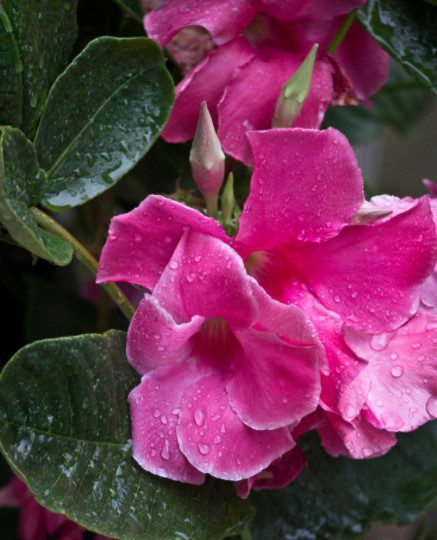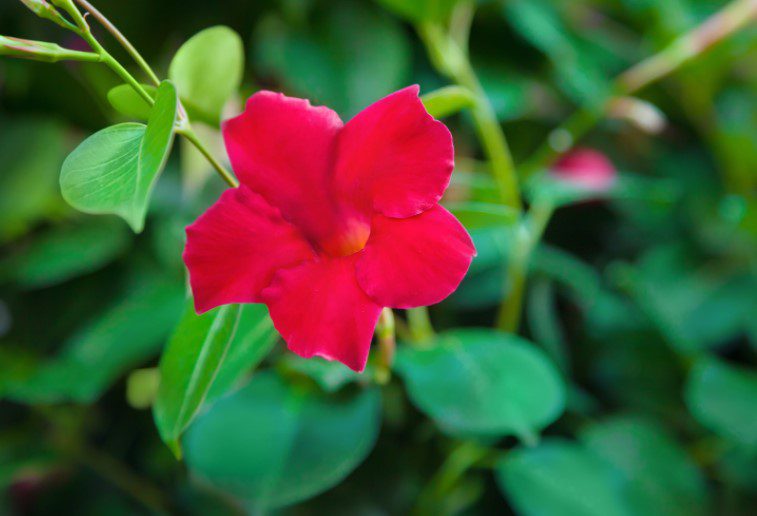1. Understand the Difference: Dipladenia and Mandevilla are climbing plants from the same family, known for their stunning trumpet-shaped flowers. However, Dipladenia is more of a bushy plant, while Mandevilla is a vigorous vine. Both are tropical natives, but Mandevilla can handle a bit more sun and tends to grow taller, while Dipladenia prefers partial shade and remains smaller.
2. Correct Soil Composition: Both plants prefer well-draining soil with a slightly acidic pH. Incorporate plenty of organic matter into the ground for nutrients, and ensure adequate drainage to prevent waterlogging. Adding compost or a balanced slow-release fertilizer can help support lush growth.
3. Ideal Temperature and Light: As tropical plants, both Dipladenia and Mandevilla enjoy warmer climates and are not frost-tolerant. They prefer temperatures between 60°F and 80°F (15°C to 27°C). As for light, Mandevilla thrives in full sun, while Dipladenia prefers partial shade, especially in hotter climates.
4. Regular Watering: Both plants require regular watering, but be careful not to overwater, as this can lead to root rot. The top inch of soil should be dry before the next watering. Both Dipladenia and Mandevilla also enjoy high humidity, which can be increased by misting or placing the pot on a tray of pebbles with water.
5. Pruning and Training: Prune these plants in early spring to maintain their shape and promote bushier growth. Mandevilla vines require support such as a trellis or stake to climb, while Dipladenia, being bushier, might not need as much help but can still benefit from careful guidance.
6. Pest Control: Both plants can be affected by pests like aphids, whiteflies, and spider mites. Regularly check the undersides of leaves and treat them with insecticidal soap or neem oil at the first sign of infestation.
By understanding these tips, you can grow Dipladenia and Mandevilla successfully, adding a tropical flair to your garden or home.
Dipladenia
The main difference between Dipladenia and Mandevilla is the vegetation. Dipladenia leaves are delicate and sharp, dark olive and somewhat silky. Mandevilla vine involves broader leaves with a larger shape.
The flowers are trumpet-defined in various colors and rich in pink, silver, yellow, and red tones. As they advance, the plants react well to pinching, which drives new bushier production. Unlike the Mandevilla, Dipladenia doesn’t move out as much skyward expansion and doesn’t require staking.
Botanical names for plants can be pretty confusing at times. As we unpacked a heap of lovely fresh plants, I was reminded of one of the most confusing plants name conundrums – what is the difference between a Dipladenia and a Mandevilla plant?
They look almost identical, with very similar foliage and trumpet-shaped flowers in white and shades of pink and red. But some are called Dipladenia, and some are called Mandevilla.

Mandevilla is a genus of tropical plants and subtropical flowering vines. They can grow several meters tall, twining their long stems around whatever they find to support them.
As well to these tall climbers, there are shorter, shrubbier forms, and these shorter ones used to be called dipladenias.
In 1933, the dipladenias were re-classified to become mandevillas, but Dipladenia persisted in-plant labeling.
Further breeding and hybridization have occurred to add to the confusion, and many new compact forms have been released using the name Mandevilla.
So, I’d suggest we pay little attention to whether they are called Mandevilla or Dipladenia and concentrate on how they grow. The Sun Parasol range is a good starting point for taller forms, which come in white, pink, red, and crimson.
Alice du Pont is an excellent vigorous climbing plant with wavy leaves and lolly pink flowers.
There are lots of shorter varieties that are brilliant for pots, including the old favorites My Fair Lady (white), Red Riding Hood (red), Scarlet Pimpernel (scarlet), Merlin’s Magic (dark pink), rRo Dipladenia and Guinevere (soft pink).
The Aloha series is another collection of compact forms in various colors.
All of them do best in a warm, full sun position, where they will flower profusely from spring through summer and into late autumn, even flowering through winter if they stay warm.
The tall growers are best in the ground or huge pots and need some support. The shorter ones are brilliant in pots or even hanging baskets. Both need excellent drainage and stay a bit dry, especially in cooler weather.
How to Grow a Dipladenia
- For optimal performance, this plant requires warm temperatures. Temperatures at night should remain between 65 and 70 degrees Fahrenheit (18-21 C).
- In the summer, water the plant frequently but allow the top few inches of soil to dry out completely before watering again. The plant can be planted in the ground or kept in a container in warmer climates.
- A Dipladenia plant requires bright indirect sunlight to thrive. The most beautiful flowers grow in well-lit areas. When the plant is young, pinch off gangly growth to encourage the formation of thicker, more substantial branches.
- Mandevilla and Dipladenia care are identical except that mandevillas require a trellis or staking. Dipladenia only requires a stake to maintain its upright position as it matures.
- Fertilize with a liquid plant food every three to four weeks during the growing season as part of proper Dipladenia care.
- Winterize indoors or in a greenhouse and halt fertilization during the winter. Even northern gardeners keep the plant growing indoors until the summer heat arrives with a little luck.
How To Care For Mandevilla
The plant is commonly referred to as Mandevilla, after John Henry Mandeville, a British minister in Argentina, where it originated. Mandevilla is not well-known, but she should be.
The perennial tropical vine plant may not be appealing in winter. Indoors in the winter, the plant may only produce an occasional blossom, and, depending on the variety of Mandevilla, the leaves are frequently yellow.
The plant will look better in winter if the growing conditions are favorable.
Regardless of how Mandevilla looks in the winter, its summer show makes it worthwhile to grow.
Some people even grow Mandevilla as a summer annual, relegating the plant to the compost pile in the winter and replacing it with a new plant in the spring.
Mandevilla prefers bright light and well-drained soil, especially in the winter when the plant prefers to sulk rather than grow. To ensure good soil drainage, add extra perlite to the potting mix you usually use for houseplants.
With more perlite, you’ll have to water more frequently in the summer, but the plant will be happier the rest of the year.
Mandevilla enjoys resting in the winter, so one option is to allow it to do so. Please place it in an out-of-the-way location.
Begin in autumn, gradually watering less to help the plant enter a semi-sleep state, then keep the plant somewhat dry and cool for a few months.
Repot a Mandevilla near the end of winter, cut back any weak stems, and relocate it to a sunnier window in a warmer room.
The plant should then begin to sprout new growth. Move it outside in the spring; the glossy leaves and vibrant flowers will create a tropical oasis throughout the summer.
Training
Left to itself, a Dipladenia will grow upwards and send out long runners looking for something to cling to.
If you want it to be a climber, you will need to provide some structure, such as a trellis, to wind the long tendrils onto as the plant grows.
To keep it as a shrub, lightly prune the plant to maintain it to the size you wish.
Water Management
Dipladenias thrive in moist environments but should not be overwatered; therefore, cover them with a thick layer of mulch.
Your plant won’t suffer too much if periodically neglected because the roots are naturally suited to store water for use in dry spells.
Water crystals can aid in keeping water in the potting mix available for the plant to use as needed.
Fertilizing
The easiest method of fertilizing is an application of Robust in October and again in April. Alternatively, year-round feed with Flourish or SeaMax Fish & Kelp — fortnightly in summer, once a month in winter — will keep the plant healthy and promote flowering.
Pruning
Tip: Regularly clip non-climbing plants to encourage bushiness. When flowering is at its lightest, in late winter or spring, make a thorough cutback. Even dipladenias that have been trained to climb benefit from annual pruning.
Pests & Diseases
Soft white scale, which can be readily handled using White Oil or Conguard, can harm Dipladenias.
A new Dipladenia called Citrine has just been released. Until now, dipladenias have been mainly available in reds and pinks, but the just-released Citrine has vivid yellow flowers.























